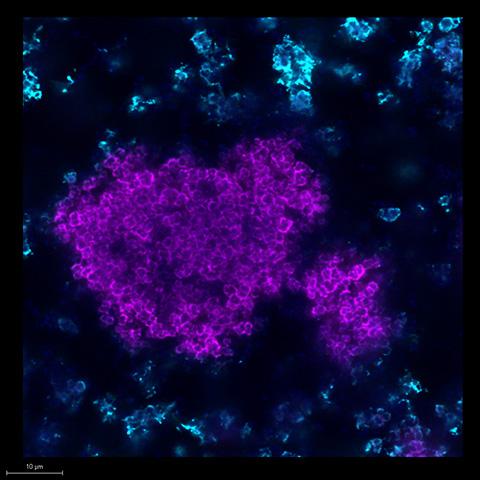After hours at the microscope, Sebastian Temme, Ph.D., was at a loss. The bacterial structures he’d been examining weren’t arranged the way he expected they’d be. He and his colleagues initially feared they’d done the experiment wrong, but they soon realized they’d latched onto something fascinating.
“It was one of those cool days where you’re like, ‘Something’s going on,’” said Temme, a research fellow in the Chemical Biology Laboratory at NCI Frederick.
Those structures, called biofilms—dense, sticky networks of bacteria adhering to each other—are implicated in an estimated 80% of all bacterial infections. Consistent with the prevailing understanding, Temme and colleagues expected to see modifications to the chemical structure of a molecule known as PNAG, required for biofilm formation, scattered randomly throughout the biofilms’ structures.
But the puzzling microscopy scans revealed that the chemical modifications to PNAG cluster up in defined areas. With this knowledge, scientists can better understand biofilms’ biochemistry and potentially devise more ways to treat them. That, in turn, could address major challenges some bacterial infections pose to human health.
The team also showed that two antibodies, including one they developed, target different regions of Staphylococcus epidermidis biofilms based on the PNAG modifications. The pairing so potently strikes the biofilms that it protected 90% of laboratory models against life-threatening S. epidermidis bacterial infection.
A study reporting on the biofilms’ structures and the antibody treatment appears in Cell Chemical Biology, with Temme as lead author.
Biofilms live on many surfaces—including in medical settings, like hospitals and surgical centers. With antibiotic resistance on the rise, they’re becoming increasingly difficult to treat. Some data suggest they can be up to 5,000 times more resistant to antibiotics than bacteria that haven’t coalesced into biofilms, a staggering challenge that makes new treatments particularly valuable.
“One of the areas where biofilms are a huge problem is implants,” said Jeff Gildersleeve, Ph.D., Temme’s supervisor, the senior author on the study, and a senior investigator in the Chemical Biology Laboratory.
‘A Lot to Learn There’
Temme and Gildersleeve gravitated toward treating biofilms after finishing a screen of human antibodies. Among the more than 500 antibodies they tested, one—now called TG10—stood out because it could bind to PNAG.
“We were aware that there’s another antibody that’s in Phase II clinical trials that also binds—or was reported to bind—deacetylated PNAG, and so that got us really interested,” Gildersleeve said.
“Deacetylated” refers to the same chemical modifications Temme saw in the microscopy scans. PNAG normally has an acetyl molecule attached to it, but some chemical reactions chop off the acetyl. The modified—“deacetylated”—PNAG is what gives a biofilm its adhesive properties.
This dependence on deacetylated PNAG could be leveraged to target biofilms or used in combination treatments.
The team further developed and patented TG10 and sought to learn what would happen if they administered it along with the antibody that’s in trials, F598, to bacterial biofilms.
These experiments in S. epidermidis led to the revelatory microscopy scans. The two antibodies zeroed in on different portions of the biofilm. One bound to acetylated PNAG, while the other hit deacetylated PNAG.
Looking at the microscopy images, Temme could clearly see a large deacetylated region in the center of the biofilm and a sheet of deacetylation across its lowest layers. Meanwhile, acetylated regions surrounded and layered overtop of the deacetylated portions.
“We realized that as a field, we know much less about biofilm architecture [than we thought]. There’s a lot to learn there, and this was something novel in terms of how the biofilm is assembled,” Gildersleeve said.
Together, the antibodies covered broad swathes of the biofilm, suggesting to the team that they might work as a combination treatment. The test with high doses of S. epidermidis reinforced that idea.
The findings are an encouraging step for potential treatments for S. epidermidis infections and for further studies into other biofilms, Temme said.
“It’s not just the PNAG that’s modified like this,” he said. “There are other exopolysaccharides of bacterial and fungal biofilms, other types of biofilms where this is potentially something that we should look into.”
The team plans to investigate these questions. Temme and Gildersleeve also aim to one day bring TG10 to clinical trials for treating bacterial and fungal infections in humans, possibly as part of a combination treatment with an antibody like F598.
Samuel Lopez leads the editorial team in Scientific Publications, Graphics & Media (SPGM). He writes for newsletters; informally serves as an institutional historian; and edits scientific manuscripts, corporate documents, and sundry other written media. SPGM is the creative services department and hub for editing, illustration, graphic design, formatting, multimedia, and training in these areas.



